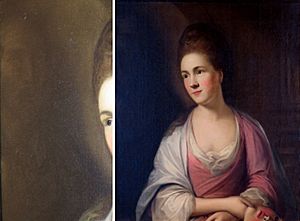Elizabeth Younge facts for kids


Elizabeth Younge (born around 1740 – died March 15, 1797) was a famous English actress. She was especially known for playing characters in plays by William Shakespeare.
Contents
Early Life and Start in Acting
Elizabeth Younge was born near Old Gravel Lane in Southwark, England. She went to a day-school with other children from working-class families. After school, she became an apprentice to a milliner, someone who makes and sells hats.
Sadly, Elizabeth's parents died when she was young. This meant she had to support herself. In her free time, she loved to read. She spent a lot of time studying famous poets, especially those who wrote plays.
Around 1767 or 1768, Elizabeth met a young woman whose father was an actor named Mr. Thompson. Mr. Thompson introduced Elizabeth to George Garrick. George was the younger brother of David Garrick, a very important theatre manager at the time.
George Garrick was impressed by Elizabeth's acting skills. He took her to meet his brother, David. This was good timing for Elizabeth. Another actress, Hannah Pritchard, had just retired. Also, David Garrick was having some problems with another actress, Ann Barry.
David Garrick liked to have talented actresses ready to perform. He hired Elizabeth for his theatre company, the Drury Lane. He even gave her personal acting lessons.
Becoming a Star Actress
Elizabeth Younge made her first appearance at Drury Lane on October 22, 1768. She played the character of Imogen in the play Cymbeline. David Garrick was very happy with her performance. He raised her salary from £2 to £3 per week.
William Hopkins, the theatre's prompter, wrote about her performance. He said she had a "very good voice" and "a great deal of acting." He felt she played the part "amazingly well."
Elizabeth took on many other roles after her first success. She played Jane Shore in The Tragedy of Jane Shore. She also played Ovisa in a new play called Zingis, which was not very popular. On April 7, 1769, she played Perdita in Florizel and Perdita. This was David Garrick's version of The Winter's Tale.
That summer, she worked in Richmond. In the autumn, she returned to Drury Lane. On October 2, she played Juliet in Romeo and Juliet.
Challenges and Successes
Elizabeth Younge continued to act at Drury Lane. In 1770, she played Imogen again. She also took on roles like Alcmena in Amphitryon and Lady Easy in The Careless Husband.
At one point, she had a disagreement with David Garrick about her salary. Because of this, she left Drury Lane for a short time. She went to the Capel Street Theatre in Dublin, where she was very successful.
After spending the summer of 1771 in Bristol, she reached an agreement with Garrick. She returned to Drury Lane and played Imogen again on September 26. Her performance was met with "Great Applause."
Elizabeth stayed at Drury Lane until 1778. During the summer months, she also performed in other cities. Her relationship with Garrick was sometimes difficult. He respected her talent but could be annoyed by her personality. Once, he even gave a main role to a less talented actress to try and upset her.
She played the role of Viola in front of King George III. However, Garrick had to send her a strong letter. This was because she tried to quit the play, saying she had a cough.
When David Garrick retired, Elizabeth Younge was the fifth highest-paid actress at Drury Lane. She earned £12 per week. After a disagreement about money with the new theatre manager, Thomas Sheridan, she moved to the Covent Garden theatre. She stayed there from 1778 until her death.
Later Life and Legacy
On August 9, 1785, Elizabeth Younge married Alexander Pope. He was a young Irish artist and actor. They had one son together.
Elizabeth had to stop her acting career on January 26, 1797, because of a serious illness. She died on Wednesday, March 15, 1797, at her home. Some records say she was 52 when she died, while others say she was 57. She was buried at Westminster Abbey on March 22.
Elizabeth Younge was a very important actress of her time. She was known for her powerful performances, especially in Shakespeare's plays.
Images for kids
-
The Actress Elizabeth Younge with Bust of Shakespeare, oil on canvas painting by Thomas Hickey, 1774, Honolulu Museum of Art. A niche with a bust of Shakespeare in the left upper corner is not visible in this photograph.
-
Elizabeth Younge as Cleopatra in 1772



